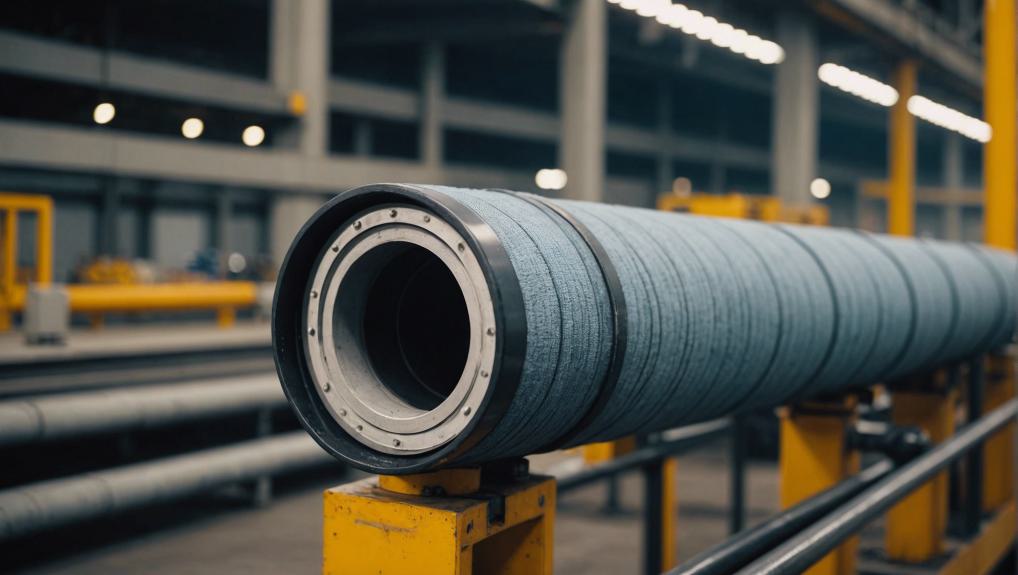
When you're selecting materials for heat-resistant fabric expansion joints, it's vital that you opt for those that can withstand high temperatures without degrading. Consider materials like fiberglass or silica, which not only resist heat but also maintain integrity under thermal stress. You'll also need to consider the chemical environment these joints will face; materials such as PTFE could be essential for chemical resistance. However, choosing the right material is just the beginning. How you design and maintain these joints plays a key role in their performance and longevity. Let's explore how these factors interplay to make sure your system remains robust and efficient.
Selecting the Right Materials
Selecting the appropriate materials for heat-resistant fabric expansion joints is essential for guaranteeing their longevity and efficiency in high-temperature environments. When you're faced with this task, you need to take into account the thermal, chemical, and mechanical properties of potential materials.
Firstly, you'll want to focus on fabrics that can withstand extreme heat. Materials such as fiberglass, silica, and ceramic offer excellent thermal resistance and are often used in environments where temperatures can reach up to 1000°C. You must make sure that the material's melting point is significantly higher than the operational temperature of the application to avoid degradation.
Apart from heat resistance, you should also take into account the fabric's resistance to corrosive chemicals. Depending on your application, the expansion joint might be exposed to acids, alkalis, or solvents. Materials like PTFE (Polytetrafluoroethylene) or coated fabrics can provide necessary chemical resistance, ensuring that your joint doesn't deteriorate prematurely.
Lastly, the mechanical durability of the material is important. It should be able to withstand the physical stresses and movements of the system without tearing or wearing out quickly. Reinforced materials or composites can offer the extra strength needed for such demanding applications. By carefully selecting your materials, you'll greatly enhance the performance and reliability of your fabric expansion joints.
Design Considerations
Having selected the right materials, you must now consider the design of your heat-resistant fabric expansion joints to guarantee peak performance. The layout and engineering of these components are essential for ensuring they meet the operational demands of your systems.
Firstly, you've got to determine the correct size and shape. This isn't just about matching dimensions; it's about understanding the movements the joint will need to accommodate. Think about thermal expansion, vibrations, and any other mechanical movements. If you underestimate these factors, you're likely to see premature failure.
Next, consider the configuration of the fabric layers and reinforcements. The arrangement should provide excellent resistance to the temperatures and pressures specific to your application. You also need to think about the stitching pattern used to assemble the fabric layers. The right pattern enhances durability and functionality under stress.
Additionally, don't overlook the importance of the joint's end fittings. These should be designed to ensure a secure and durable connection with the adjacent equipment. Choosing the wrong fittings can lead to leaks or detachment, compromising the system's integrity.
Tailor each aspect carefully to your specific operational requirements. This attention to detail will help ensure your expansion joints perform reliably under all expected conditions.
Maintenance and Inspection Practices
In order to guarantee that your heat-resistant fabric expansion joints continue to function at their best, regular maintenance and thorough inspections are essential. You'll need to develop a routine that fits the specific demands of your system and the environment in which it operates.
Start by visually inspecting the joints for signs of wear or damage, such as fraying, tears, or discoloration. These can be indicators of excessive heat exposure or mechanical stress. Don't overlook the importance of checking for loose or corroded fasteners, and make sure the joint's anchorage is secure.
It's wise to perform these inspections at least every six months, although more frequent checks might be necessary in harsh environments. Documenting each inspection is crucial; this history can help you identify patterns of wear or recurring issues, which can inform future maintenance and potentially prevent failures.
Cleaning the joints is also important; dust and debris can accumulate and affect performance. Use a soft brush or a vacuum to clean the surface gently.
Conclusion
In wrapping up, always choose materials like fiberglass or ceramic for your heat-resistant fabric expansion joints to withstand high temperatures. Design them thoughtfully to accommodate thermal movements and make sure they're reinforced for pressure.
Don't skip on regular maintenance and inspections; they're key to prolonging the life and performance of your joints. By sticking to these guidelines, you'll maximize durability and efficiency, keeping your systems running smoothly under any condition.
© Copyright 2024. All RIghts Reserved
